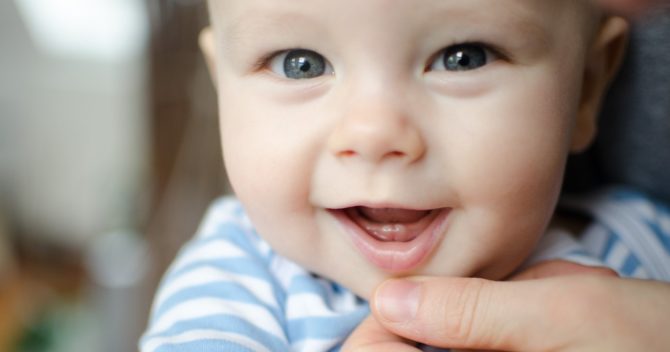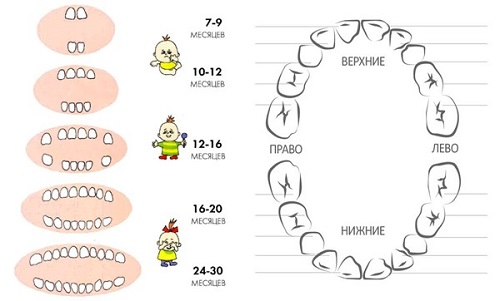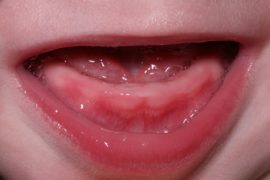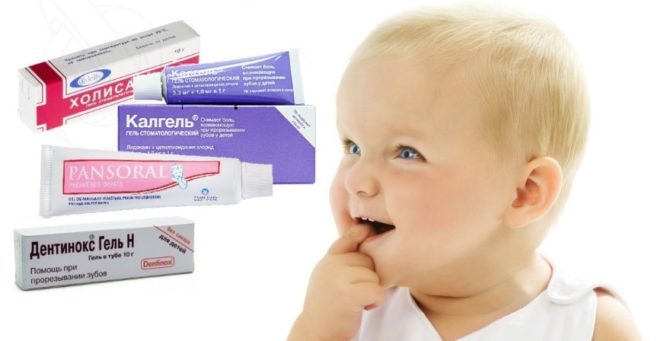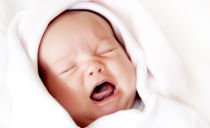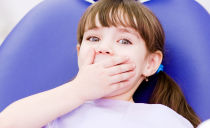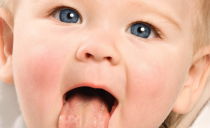Teething gels for teething babies and children
The appearance of the first incisors in infants is very painful. You can relieve teething discomfort with painkillers.which are produced specifically for young children. To deal with their types, names and features of the application, mothers and fathers should be in advance in order to select the best remedy for their baby at the crucial moment.
Content
When and how do teeth begin to be cut?
It is impossible to predict the time of appearance of teeth in a newborn. Most often, the first tooth becomes noticeable in 6-8 months. But for some children, this event occurs as early as 4 months, and someone expects it only at the end of the first year of life.
Duration of teething can depend on heredity: on how quickly teeth grew in parents, grandparents. And also from the course of pregnancy in mom. From how she ate at that time, what she was sick with and what medications she was taking, especially at the end of the first trimester and at the beginning of the second, when the fetus forms tooth rudiments. The main thing is that the period of their appearance does not affect the quality of the teeth.
A complete set of milk teeth is formed by 2.5–3 years. And before that, the baby is forced to periodically feel discomfort in her mouth. Someone will be more lucky, and the teeth will hatch almost imperceptibly, and someone will need medical help, which consists in the use of a dental gel, which is designed just to facilitate teething in children.
Milk teeth grow in the order established by nature (excluding individual variations):
- the two lower incisors erupt at about 6–8 months;
- two upper incisors - a month after the lower;
- upper and lower lateral incisors - approximately 10 months;
- molars or molars - from 12 to 18 months;
- lower and upper fangs - 2 months after the molars;
- second molars - from 2 to 3 years.
The most painful crumbs suffer the eruption of the first incisors, as well as of the molars. Parents should be ready to navigate the situation on time in order to understand what is happening with the little one and to know how to help him.
How to understand that a child’s teething has begun
There comes a time when the baby becomes especially troubled. He is naughty, sleeps poorly and eats, tries to nibble everything and drools. This behavior may be a harbinger of a change in the mouth in the near future.
But it is impossible to exclude completely different causes of childhood ailment. All doubts must be discussed with your doctor, especially if severe anxiety is accompanied by fever, diarrhea, and other serious manifestations.
Teething patterns may also be individual. Possible symptoms:
-
The kid worries, whimpers, at times cries loudly. At the same time, he can clutch his cheeks or ears.
- He actively chews fingers and toys, the process is accompanied by increased salivation.
- Poorly eats, spits out food, a pacifier or a maternal nipple.
- He falls asleep for a long time and often wakes up.
- Body temperature can jump to 38.5 ° C.
- Swallowing saliva may cause a cough, runny nose, and / or loose stools.
- A white strip or a spot appears on the gum in the place of the cutting tooth, the area of the mucous membrane may turn red and slightly swell (in the photo).
In this state, the child can stay for several days. If symptoms persist, consult a doctor. It is worth contacting a pediatrician in cases where the temperature initially exceeds 38.5 °C, or diarrhea occurs more than three times a day. It may not be the teeth at all.
How to help the baby
If there is no doubt, and the uncomfortable state is really caused by pain in the gums, there are improvised ways to make life easier for the little sufferer. They should be used to the maximum, trying to avoid the use of medications.
An effective remedy is gum massage. It will relieve itching and tension in the soft tissues, activate blood circulation, reduce swelling and help the tooth penetrate faster. The massage is performed with a clean finger or a piece of gauze soaked in cool water, with light movements back and forth.
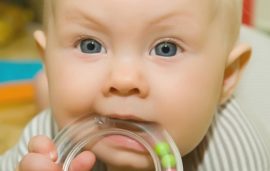 The baby is able to massage the gums himself, if you give him a chewing special tooth teether (pictured). In addition to massage, this item will also provide a pleasant cooling effect if you cool it in advance in the refrigerator.
The baby is able to massage the gums himself, if you give him a chewing special tooth teether (pictured). In addition to massage, this item will also provide a pleasant cooling effect if you cool it in advance in the refrigerator.
To remove inflammation in the oral cavity, lotions with decoctions of chamomile, calendula or sage will help. And always by all means you need to distract the baby's attention from pain: to communicate with him, play, calm, carry on hand.
If none of the above brings even temporary relief, you will have to take medical help. Should a baby give painkillers and antipyretics, what and how much, in each specific situation, the pediatrician should decide.
Special baby gels for local anesthesia and relieving gum inflammation will help the infant and parents survive this difficult period. Their choice in pharmacies is quite wide.
Gums anesthetics gels for children: varieties
All dental gels existing in pharmacy showcases are divided into three main groups:
- homeopathic;
- painkillers (anesthetics);
- antiseptic.
Which gel is best used for teething in a child depends on its condition. Moderate gum disease, which causes only slight discomfort, will remove the ointment or gel with extracts of medicinal plants. These are the maximum safe for a small organism natural natural remedies. Such a teething gel from 3 months can be smeared without fear, provided that the child is not allergic to plant components.
To help anesthetizing gels when teething in children, they resort only to a bright inflammatory process with unbearable pain. Synthetics with a local anesthetic effect, such as lidocaine or benzocaine, reduce pain.
The analgesic effect of such an ointment when teething occurs instantly and lasts up to several hours. The problem is that anesthetics, absorbed into the blood, can cause some harm to the body. And because of the cooling effect, they can cause numbness or tingling of the tongue, make it difficult to suck and ruin your appetite. Therefore, the use of such local painkillers is recommended only in extreme cases and strictly in the prescribed dosage.
With severe inflammation and the presence of suppuration on the gums, the doctor will recommend lubricating the source of infection with antiseptic gels and ointments. They will not only relieve inflammation, but also stop the growth of pathogenic bacteria. Their dosage is also limited.
Teething Gel for Babies: Which is Better
According to pharmacy chains, among the gels used in teething in infants, the greatest demand is:
- Dentinox is a teething gel for children older than 4 months.Its active ingredients - lidocaine hydrochloride and pharmacy chamomile extract - provide both local anesthetic, anti-inflammatory and light antiseptic effects. It can be applied two to four times a day. There is a drug with a similar composition called Kamistad, but due to the high content of lidocaine, it is not recommended for babies under 12 years old.
- Calgel is an anesthetic with an antimicrobial effect. Along with lidocaine, it contains the antiseptic cetylpyridinium chloride. The percentage of active ingredients makes it possible to use Kalgel for teething in children from three months. Frequency of use - up to 6 times a day. A contraindication, in addition to sensitivity to the components of the drug, may be hereditary intolerance to the fructose contained in the drug as an excipient.
- Denthol-baby is a fast-acting benzocaine-based anesthetic. It is allowed from four months and can be applied 4 times a day, but not longer than seven consecutive days. The analgesic effect lasts only 20 minutes.
Parents who do not lose hope of using gels when teething without lidocaine, most often choose the following items:
- Baby doctor - gel for relieving symptoms of teething, approved for use from 3 months and including only natural components: extracts from chamomile, calendula, echinacea, marshmallow and plantain roots. Gently relieve inflammation and enhance local immunity, but does not have a persistent analgesic effect. You can rub it as many times a day as needed: no restrictions.
- Cholisal is a local anesthetic, antimicrobial and antifungal drug based on cetalkonium chloride. It keeps well on the mucosa, due to which it has a long - from 2 to 8 hours - facilitating effect. It is carefully rubbed into the gums 2-3 times a day, however, under the age of one year apply Holisal with caution: allergic reactions and short-term burning immediately after application are possible.
In exceptional cases associated with damage to the mucosa, Pansoral is prescribed - an antiseptic that is indicated for ulcerative symptoms on the mucous membranes of the oral cavity. Up to periodontal disease and severe tonsillitis. This powerful drug should only be used as directed by a dentist at the age of no earlier than 2.5 years.
General rules for the use of dental gels
Any gel for analgesia for teething has its own characteristics of application and effects on the body, probable side effects and contraindications. Therefore, rule number 1 - carefully study the instructions Before you test the effect of the drug on your child, and strictly adhere to the recommended dosages and frequency of use. And if possible, discuss the choice with the doctor, especially if the baby has chronic diseases or a tendency to allergies.
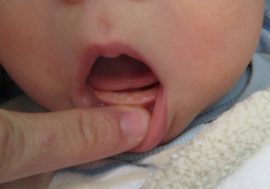 Gels, which include anesthetics, should be used only when the gum hurts unbearably, and the rest is helpless.
Gels, which include anesthetics, should be used only when the gum hurts unbearably, and the rest is helpless.
You can anoint the inflamed area with your finger after thoroughly washing your hands, rubbing the substance into the mucous membrane with massage circular movements. And you can anoint the gum with a cotton or gauze swab. Regardless of the method of application, the amount of medicine should be very small.
Adults should provide for the storage of the medicine package out of the reach of the child.
Surviving the appearance of the first teeth in a newborn is not easy for the whole family. But this period will not be very long and very soon only memories will leave about itself. To have patience and necessary information, to be attentive and not to neglect the advice of doctors - these are the best that adults can help their beloved man.

